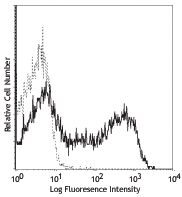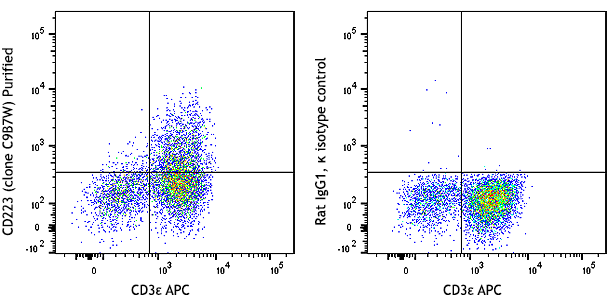- Clone
- A16124J (See other available formats)
- Regulatory Status
- RUO
- Other Names
- B cell maturation antigen (BCMA), tumor necrosis factor receptor superfamily member 17, CD269
- Isotype
- Rat IgG2a, κ
- Ave. Rating
- Submit a Review
- Product Citations
- publications

-

Biotinylated recombinant mouse TNFRSF17 (black circles) binds to immobilized recombinant mouse TNFSF13. Ultra-LEAF™ purified anti-mouse CD269 (BCMA) antibody (clone A16124J) (purple squares) inhibits the binding in a dose-dependent manner whereas GoInVivo™ purified rat IgG2a, κ isotype ctrl antibody (Cat. No. 400562) (gray triangles) does not have the effect. This antibody blocks the binding of 0.5 µg/mL biotinylated recombinant mouse TNFRSF17 to 0.5 µg/mL of immobilized recombinant mouse TNFSF13. ND50 range: 0.2 - 1.5 µg/mL.
| Cat # | Size | Price | Quantity Check Availability | Save | ||
|---|---|---|---|---|---|---|
| 943603 | 100 µg | $325 | ||||
| 943604 | 1 mg | $1045 | ||||
Mouse TNFRSF17-Fc chimera is a type I attached membrane protein of 185 amino acids, which possesses a conserved motif of six cysteines in the N-terminal. It is consistent with the formation of a cysteine repeat motif found in the extracellular domain of TNFRs, and is 62% identical to the human receptor. The overexpression of TNFRSF17-Fc chimera in 293E cells activates NF-κB, Elk-1, the c-Jun N-terminal kinase, and the p38 mitogen-activated protein kinase. After its association with TNF receptor-associated factor (TRAF) 1, TRAF2, and TRAF3. Soluble forms of TACI (TNFRSF13B) and TNFRSF17-Fc chimera bind to BAFF (TNFSFL13B) and APRIL (TNFSFL13A). The interaction of TNFRSF17-Fc chimera to APRIL has higher affinity than the TNFRSF17-BAFF interaction. Analysis of BCMA knockout mice (BCMA−/−) showed no differences in the steady-state frequencies or composition of peripheral B cell subsets (immature, marginal zone, follicular, B1). BCMA expression is upregulated on PBMCs from mice that develop a Sjogren’s-like syndrome, patients with Sjogren’s syndrome, with rheumatoid arthritis, and on B cells from SLE patients. TNFRSF17/BCMA/CD269 is a receptor for TALL-1 and BCMA activates NF-κB through a TRAF5-, TRAF6-, NIK-, and IKK-dependent pathway. The identification of TNFRSF17 as a NF-κB-activating receptor for TALL-1 suggests molecular targets for drug development against certain immunodeficient or autoimmune diseases. Antibody responses to cell-surface BCMA may contribute directly to tumor rejection in vivo.
Product DetailsProduct Details
- Verified Reactivity
- Mouse
- Antibody Type
- Monoclonal
- Host Species
- Rat
- Immunogen
- Recombinant mouse TNFRSF17
- Formulation
- 0.2 µm filtered in phosphate-buffered solution, pH 7.2, containing no preservative.
- Endotoxin Level
- Less than 0.01 EU/µg of the protein (< 0.001 ng/µg of the protein) as determined by the LAL test.
- Preparation
- The Ultra-LEAF™ (Low Endotoxin, Azide-Free) antibody was purified by affinity chromatography.
- Concentration
- The antibody is bottled at the concentration indicated on the vial, typically between 2 mg/mL and 3 mg/mL. Older lots may have also been bottled at 1 mg/mL. To obtain lot-specific concentration and expiration, please enter the lot number in our Certificate of Analysis online tool.
- Storage & Handling
- The antibody solution should be stored undiluted between 2°C and 8°C. This Ultra-LEAF™ solution contains no preservative; handle under aseptic conditions.
- Application
-
Block - Quality tested
- Recommended Usage
-
Each lot of this antibody is quality control tested by blocking the binding of biotinylated recombinant mouse TNFRSF17 at 0.5 µg/mL to immobilized recombinant mouse TNFSF13 at 0.5 µg/mL. ND50 range: 0.2 - 1.5 µg/mL. It is recommended that the reagent be titrated for optimal performance for each application.
- RRID
-
AB_2892507 (BioLegend Cat. No. 943603)
AB_2892507 (BioLegend Cat. No. 943604)
Antigen Details
- Structure
- CD Molecules
- Distribution
-
Resting and activated B cells, plasma blasts, plasma cells
- Function
- B cell maturation factor, maintains the peripheral B cell population and survival of long-lived bone marrow plasma cells, soluble BCMA acts as a decoy receptor for APRIL (TNFSFL13A).
- Interaction
- Associates with several TRAF family members, monocytes, macrophages, T cells, and dendritic cells
- Ligand/Receptor
- TNFSF13 (APRIL) and TNFSF (BAFF)
- Antigen References
-
- Madry C, et al. 1998. Int. Immunol. 10:1693.
- Hatzoglou A, et al. 2000. J. Immunol. 165:1322.
- Rennert P, et al. 2000. J. Exp. Med. 192:1677.
- Wallweber HJ, et al. 2004. J. Mol. Biol. 343:283.
- O'Connor BP, et al. 2004. J. Exp. Med. 199:91.
- Kim J, et al. 2011. Autoimmunity. 44:69.
- Coquery CM, Erickson LD. 2012. Crit. Rev. Immunol. 32:287.
- Laurent SA, et al. 2015. Nature Commun. 6:7333.
- Gene ID
- 21935 View all products for this Gene ID
- UniProt
- View information about CD269 on UniProt.org
Related Pages & Pathways
Pages
Related FAQs
- Do you guarantee that your antibodies are totally pathogen free?
-
BioLegend does not test for pathogens in-house aside from the GoInVivo™ product line. However, upon request, this can be tested on a custom basis with an outside, independent laboratory.
- Does BioLegend test each Ultra-LEAF™ antibody by functional assay?
-
No, BioLegend does not test Ultra-LEAF™ antibodies by functional assays unless otherwise indicated. Due to the possible complexities and variations of uses of biofunctional antibodies in different assays and because of the large product portfolio, BioLegend does not currently perform functional assays as a routine QC for the antibodies. However, we do provide references in which the antibodies were used for functional assays and we do perform QC to verify the specificity and quality of the antibody based on our strict specification criteria.
- Does BioLegend test each Ultra-LEAF™ antibody for potential pathogens?
-
No, BioLegend does not test for pathogens in-house unless otherwise indicated. However, we can recommend an outside vendor to perform this testing as needed.
- Have you tested this Ultra-LEAF™ antibody for in vivo or in vitro applications?
-
We don't test our antibodies for in vivo or in vitro applications unless otherwise indicated. Depending on the product, the TDS may describe literature supporting usage of a particular product for bioassay. It may be best to further consult the literature to find clone specific information.
Other Formats
View All CD269 Reagents Request Custom Conjugation| Description | Clone | Applications |
|---|---|---|
| Ultra-LEAF™ Purified anti-mouse CD269 (BCMA) | A16124J | Block |
Customers Also Purchased
Compare Data Across All Formats
This data display is provided for general comparisons between formats.
Your actual data may vary due to variations in samples, target cells, instruments and their settings, staining conditions, and other factors.
If you need assistance with selecting the best format contact our expert technical support team.
-
Ultra-LEAF™ Purified anti-mouse CD269 (BCMA)

Biotinylated recombinant mouse TNFRSF17 (black circles) bind...

 Login/Register
Login/Register 













Follow Us